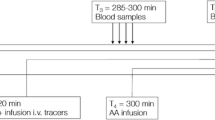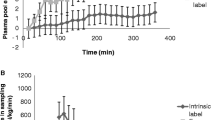Abstract
Objective
We investigated the amino acid (AA) tolerance during Total Parenteral Nutrition (TPN) in adult patients undergone liver transplant (LTX).
Design
The treatment (Glucose and AA), induced on the 2nd postoperative day, was later maintained with 27 kcal/kg Ideal Body Weight (IBW) as glucose and 0.12 (12 patients: protocol #1), 0.18 (10 patients: protocol #2) and 0.25 g nitrogen (N)/kg IBW (13 patients: protocol #3) till end of the 6th postoperative day. The N intake was sequentially modified in protocol #2 and #3 to increase the supply of the amino acid (AA) that resulted in an infusion plasma level below the expected “normal” range (between 1 and 1.6 times the overnight fasting plasma level of volunteer).
Patients
35 consecutive adult patients without diabetes and organ failures for the entire study period.Measurements: Plasma AA profile was measured before LTX and at the last TPN day under continuous infusion. During #1 and #2 protocol, many AA resulted below or at the lower range of the norm while, during 0.25 gN/kg IBW infusion, the majority of the administered AA significantly increased with respect to reference values. Nevertheless, they remained in the “normal” plasma range indicating that they were supplied in an optimal amount (particularly the aromatic and sulphurated ones, potentially toxic if liver function is impaired, and the branched chain AA (BCAA) given at consistent dosage: 0.5 g/kg). Arginine resulted significantly increased (Arg: 1.9 times the reference) and cystine (Cys: 0.45), serine (Ser: 0.8) and taurine (Tau: 0.85) remained significantly lower than “normal” as well as the not administered citrulline (Cit: 0.58) and alfa amino butyric acid (Aba: 0.41). The AA (and calorie) load almost balanced the N losses during the 5th (0.411±0.038) and 6th study day (0.305±0.019 gN/kg).
Conclusions
0.25 gN/kg could be considered the minimum N load in the uncomplicated adult LTX recipients, for reassuring a balanced plasma AA pattern and body N turnover in the early postoperative phase.
Similar content being viewed by others
References
Starzl TE, Demetris AJ, Van Thiel D (1989) Liver transplantation. N Engl J Med 321:1092–1099
Jenkins RL, Clowes GHA, Borsari S, Pearl RH, Khetry U, Trey C (1986) Survival from hepatic transplantation. Ann Surg 204:364–374
Rudman D, Kutner M, Ausley J, Jansen R, Chipponi J, Bain RP (1981) Hypotyrosinemia, hypocystynemia, and failure to retain nitrogen during total parenteral nutrition of cirrhotic patients. Gastroenterology 81:1025–1035
Elwyn DH (1980) Nutritional requirements of adult surgical patients. Crit Care Med 8:9–20
Shanbhogue LK, Bistrian BR, Jenkins RL, Randall S, Blackburn GL (1987) Increased protein catabolism without hypermetabolism after human orthotopic liver transplantation. Surgery 101: 146–149
Greig PD, Elwyn DH, Askanazi J, Kinney JM (1987) Parenteral nutrition in septic patients: effect of increasing nitrogen intake. Am J Clin Nutr 46: 1040–1047
Iapichino G, Radrizzani D, Colombo A, Ronzoni G, Pasetti G, Bonetti G, Corbetta C (1992) Plasma amino acid concentration changes during total parenteral nutrition in critically ill patients. Clin Nutr 11:358–364
Frame EG (1958) The levels of individual free amino acids in the plasma of normal man at various intervals after a high protein meal. J Clin Invest 37:1710–1723
Bergström J, Fürst P, Vinnars E (1990) Effect of a test meal, without and with protein, on muscle and plasma free amino acids. Clin Sci 79:331–337
Harper AE (1983) Dispensable and indispensable amino acid interrelationship. In: Blackburn GL, Grant JP, Young VR (eds) Amino acids. metabolism and medical application. Wright, Boston, pp 105–121
Young VR, Bier DM, Pellet PL (1989) A theoretical basis for increasing current estimates of the amino acid requirements in adult man, with experimental support. Am J Clin Nutr 50:80–92
Pearl RH, Clowes GHA, Loda M, Jenkins RL, Trey C, Palmer K (1985) Hepatocyte function measured by central plasma clearance of amino acids: a method for patients selection and postoperative management in human liver transplantation. Transplant Proc 17:276–278
Iapichino G, Radrizzani D, Scherini A, Malacrida R, Bonetti G, Leoni L, Della Torre P, Ronzoni G, Colombo A, Marengo M, Damia G (1988) Essential and nonessential aminoacid requirement in injured patients receiving total parenteral nutrition. Intensive Care Med 14:399–405
Cerra FB, Cheung NK, Fischer JE, Kaplowitz N, Schiff ER, Dienstag JL, Bauer RH, Mabry CD, Leevy CM, Chiernam T (1985) Disease-specific amino acid infusion (F 080) in hepatic encephalopathy: a prospective, randomized, double blind, controlled trial. JPEN 9:288–295
Cerra FB, Mazuski JE, Chute E, Nuwer N, Teasly K, Lysne J, Shronts EP, Konstantinides FN (1984) Branched chain metabolic support. A prospective, randomized, double-blind trial in surgical stress. Ann Surg 199:286–291
Cascino A, Cangiano C, Fiaccadori F, Ghinell F, Merli M, Pelosi G, Riggio O, Rossi-Fanelli FR, Sacchini D, Stortoni M, Capocaccia L (1982) Plasma and cerebospinal fluid aminoacid patterns in hepatic encephalopathy. Dig Dis Sci 27:828–832
Tessari P, Inchiostro S, Biolo G, Trevisan R, Fantin G, Marescotti MC, Iori E, Tiengo A, Crepaldi G (1987) Differential effects of hyperinsulinemia and hyperaminoacidemia of leucinecarbon metabolism in vivo. J Clin Invest 79:1062–1069
Castellini P, Luzi L, Simonson DC, Haymond MW, De Fronzo RA (1987) Effect of insulin and plasma amino acid concentrations on leucine metabolism in man. Role of substrate availability on estimates of whole body protein synthesis. J Clin Invest 80:1784–1793
Barbul A (1986) Arginine: biochemistry, physiology, and therapeutic implications. JPEN 10:227–238
Reilly J, Mehta R, Teperman L, Cemaj S, Tzakis A, Yanaga K, Ritter P, Rezak A, Makowka L (1990) Nutritional support after liver transplantation: a randomized prospective study. JPEN 4:386–391
Pacy PJ, Garrow JS, Ford GC, Merritt H, Halliday D (1988) Influence of amino acid administration on whole-body leucine kinetics and resting metabolic rate in postabsorptive normal subjects. Clin Sci 75:225–231
Frexes-Steed M, Warner ML, Bulus N, Flakoll PJ, Abumrad NN (1990) Role of insulin and branched-cain amino acids in regulating protein metabolism during fasting. Am J Physiol 258:E907-E917
Bennett WM, Connacher AA, Scrimgeour CM, Rennie MJ (1990) The effect of the amino acids infusion on leg protein turnover assessed by Ö-[15N] phenylalanine and L-[1-13C] leucine exchange. Eur J Clin Invest 20:41–50
Author information
Authors and Affiliations
Rights and permissions
About this article
Cite this article
Iapichino, G., Radrizzani, D., Bonetti, G. et al. Early metabolic treatment after liver transplant: Amino acid tolerance. Intensive Care Med 21, 802–807 (1995). https://doi.org/10.1007/BF01700962
Received:
Accepted:
Issue Date:
DOI: https://doi.org/10.1007/BF01700962




